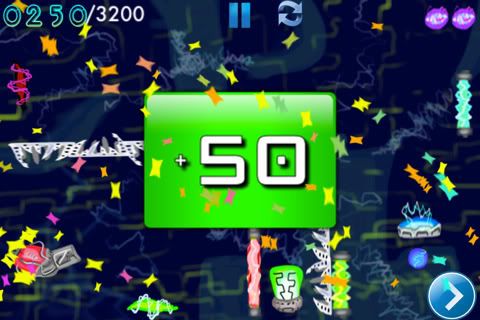My experience as a (wannabe) game developer
As a gamer one of the things that’s most interested me is, well, making games! So, in the last couple months, that’s exactly what I did  After releasing my game I found the experience really interesting and I wanted to share my experience developing a game from scratch with a bunch of people who would also find game development fascinating…fellow gamers!
After releasing my game I found the experience really interesting and I wanted to share my experience developing a game from scratch with a bunch of people who would also find game development fascinating…fellow gamers!
So I recently released my iPhone game Quantum Cannon http://itunes.apple.com/app/quantum-cannon/id427407981?mt=8, it took me about 2 and half months and cost around $350 to make. It really was one of the most fun and frustrating 2 months of my life and I would encourage anyone who is passionate abut games to give it a go. So this is basically just a blog talking about my experience as a game developer and giving some tips to anyone who wants to try it out.
All right, so, when making a game the first thing your gonna need is…a game to make! It might sound obvious but if you actually have an idea and some basic concepts floating around your mind of what you want to make, it will be a lot easier to actually make something. Take it from me, I was so over excited that I bought a MacBook pro, downloaded a bunch of programs, watched a bunch of videos about making apps and then at sat down in front my MacBook at went “…Wait, what am I actually making!” Luckily for me, my game sort of came about naturally. As I was teaching myself how to create various mechanics such as make an object accelerate, follow your touch, go up and down etc., I kept adding these mechanics onto the same level and eventually thought “hey, I can make a game outta this!”

So the first step would be to get a notepad and just sketch out a few levels, write down what kind of ideas you have and draw some concept art. This way, once you get down to making the game you’ll have a clear goal and actually know what you want to achieve, instead of doing what I did and spending hours just randomly making things accelerate into each other in the hopes that something brilliant would occur (spoiler alert: nothing brilliant will occur).
The next step would be to research how you are going to make the game. Get knowledge of the ins and outs of GS, watch the cookbook videos and ask questions in the forums, if you really want something extensive check out Photics GS textbook.

Once you know what you’re making and how you’re making it, the next step I would recommend you do is get your graphics in order. I say this because of what happened to me: I made about 20 levels before I started working with artists for my graphics. Now, I had an idea of what I wanted the game to look like and had based by 20 levels around that idea, but then the artists sent me my graphics…and they were nothing like I wanted! They were however COMPETELY SUPER MEGA AWESOME! Now this lead to good and bad news. The good news was that I had COMPLETELY SUPER MEGA AWESOME graphics, the bad news was that when I put my graphics into the game, all 20 levels became utterly useless. Everything was sized wrong, rotated in the wrong direction, placed in weird positions and was just a complete mess in general. The moral of the story is, make sure you know what you’re doing before you do it. I had based my level around shapes and sizes of objects whose shapes and sizes I didn’t know and it meant I had to start everything from scratch. Now if your making your own graphics then this may not be a huge problem a you can control what your art is going to be like. But if you’re hiring an artist then this goes back to my first point of drawing up your levels first, simply because, it’s a whole lot easier to edit a pencil drawing than to remake an entire (edit: 20 entire) game level(s).

Once that debacle had been rectified it was on to making my game. And this brings me onto my final piece of advice for this blog. Be a business owner. Its one thing to be a student in your bedroom trying to develop a game as quickly as possible and with no budget. It’s a completely different thing to be a game developer trying to make a profitable product. As I said, I started out with a deadline of 1 month and a budget of $100, but somehow I ended up releasing after 2 and half months with $350 sunk into the project. So you need to be a business owner, you need to manage your time efficiently and plan ahead taking all costs into consideration from the get go. For example, here’s a fun fact, Apple take 30% of all your app sales! Oh, wait you already knew that? That seems fair does it, considering they let you develop and sell on their platform? Well here’s another fun fact, Apple charge $100 just to have the privilege of being able to develop and sell on their platforms. Wait, that was a mistake, they charge $100 annually. Now in my excitement to make a game I neglected a lot of research and only found out about this cost after I was committed to making my game. I also severely underestimated how hard it would be to make graphics and how expensive it would be to hire an artist. These and several other factors meant that I hade to go WAY past budget to make my game and if I had known it would cost me this much to just put a game out which would only return 70 cents per sale and give me a recurring cost of $100 per year, I would have seriously reconsidered! (Although, if that were the case, then the world would have missed out on the awesomeness that is Quantum Cannon, so I guess in the long run it was all worth it ).
).
So there you go! My tips on stating an iPhone game, I hope you enjoyed the read and learnt from my many, many mistakes and I hope this encourages some people to get out there and start developing! And if your feeling really generous why not check out Quantum Cannon and tell me what you think!
Also, note: “Hey babe, want to have some fun touching my quantum cannon” is NOT a good pickup line…believe me, I tried
So I recently released my iPhone game Quantum Cannon http://itunes.apple.com/app/quantum-cannon/id427407981?mt=8, it took me about 2 and half months and cost around $350 to make. It really was one of the most fun and frustrating 2 months of my life and I would encourage anyone who is passionate abut games to give it a go. So this is basically just a blog talking about my experience as a game developer and giving some tips to anyone who wants to try it out.
All right, so, when making a game the first thing your gonna need is…a game to make! It might sound obvious but if you actually have an idea and some basic concepts floating around your mind of what you want to make, it will be a lot easier to actually make something. Take it from me, I was so over excited that I bought a MacBook pro, downloaded a bunch of programs, watched a bunch of videos about making apps and then at sat down in front my MacBook at went “…Wait, what am I actually making!” Luckily for me, my game sort of came about naturally. As I was teaching myself how to create various mechanics such as make an object accelerate, follow your touch, go up and down etc., I kept adding these mechanics onto the same level and eventually thought “hey, I can make a game outta this!”

So the first step would be to get a notepad and just sketch out a few levels, write down what kind of ideas you have and draw some concept art. This way, once you get down to making the game you’ll have a clear goal and actually know what you want to achieve, instead of doing what I did and spending hours just randomly making things accelerate into each other in the hopes that something brilliant would occur (spoiler alert: nothing brilliant will occur).
The next step would be to research how you are going to make the game. Get knowledge of the ins and outs of GS, watch the cookbook videos and ask questions in the forums, if you really want something extensive check out Photics GS textbook.

Once you know what you’re making and how you’re making it, the next step I would recommend you do is get your graphics in order. I say this because of what happened to me: I made about 20 levels before I started working with artists for my graphics. Now, I had an idea of what I wanted the game to look like and had based by 20 levels around that idea, but then the artists sent me my graphics…and they were nothing like I wanted! They were however COMPETELY SUPER MEGA AWESOME! Now this lead to good and bad news. The good news was that I had COMPLETELY SUPER MEGA AWESOME graphics, the bad news was that when I put my graphics into the game, all 20 levels became utterly useless. Everything was sized wrong, rotated in the wrong direction, placed in weird positions and was just a complete mess in general. The moral of the story is, make sure you know what you’re doing before you do it. I had based my level around shapes and sizes of objects whose shapes and sizes I didn’t know and it meant I had to start everything from scratch. Now if your making your own graphics then this may not be a huge problem a you can control what your art is going to be like. But if you’re hiring an artist then this goes back to my first point of drawing up your levels first, simply because, it’s a whole lot easier to edit a pencil drawing than to remake an entire (edit: 20 entire) game level(s).

Once that debacle had been rectified it was on to making my game. And this brings me onto my final piece of advice for this blog. Be a business owner. Its one thing to be a student in your bedroom trying to develop a game as quickly as possible and with no budget. It’s a completely different thing to be a game developer trying to make a profitable product. As I said, I started out with a deadline of 1 month and a budget of $100, but somehow I ended up releasing after 2 and half months with $350 sunk into the project. So you need to be a business owner, you need to manage your time efficiently and plan ahead taking all costs into consideration from the get go. For example, here’s a fun fact, Apple take 30% of all your app sales! Oh, wait you already knew that? That seems fair does it, considering they let you develop and sell on their platform? Well here’s another fun fact, Apple charge $100 just to have the privilege of being able to develop and sell on their platforms. Wait, that was a mistake, they charge $100 annually. Now in my excitement to make a game I neglected a lot of research and only found out about this cost after I was committed to making my game. I also severely underestimated how hard it would be to make graphics and how expensive it would be to hire an artist. These and several other factors meant that I hade to go WAY past budget to make my game and if I had known it would cost me this much to just put a game out which would only return 70 cents per sale and give me a recurring cost of $100 per year, I would have seriously reconsidered! (Although, if that were the case, then the world would have missed out on the awesomeness that is Quantum Cannon, so I guess in the long run it was all worth it
So there you go! My tips on stating an iPhone game, I hope you enjoyed the read and learnt from my many, many mistakes and I hope this encourages some people to get out there and start developing! And if your feeling really generous why not check out Quantum Cannon and tell me what you think!
Also, note: “Hey babe, want to have some fun touching my quantum cannon” is NOT a good pickup line…believe me, I tried


Comments
Cant expect to make something from nothing
Investment is part of the process, stick with it and eventually you'll get it back
Stick with it, get 6 good games out there, and each one will bring you 300/year
Send and Receive Data using your own Server Tutorial! | Vote for A Long Way Home on Steam Greenlight! | Ten Years Left
For the average game made with game salad.. You prolly need 8-10 to make about 1,000 bucks a month.. again it all depends on the quality of your game and your luck in the app store.
I guess we each have similar stories and yet our own path to travel. I think it has to be fun and we have to enjoy creating something from raw ingredients, otherwise it's too hard. The love of it and joy comes through in the end result of the work, so makes the product better.
For myself I've learned that "rapid prototyping" works better: using basic actors with names on them and no graphics initially helps keep me focused on the mechanics of the game play and logic, and therefore helps me to arrive and something that works a little sooner.
With that said, the reality check of making sure the graphics work (size wise or not crashing or slowing down the game, for example) do seem to be just as important.
I think the trick is to persevere, have fun and never give up. I have still to release my first game after well over a year but I've learned so much and have three projects in development. All have benefited from learning by my mistakes and rebuilding a lot.
My feeling is that we are just getting to a really good place with Gamesalad, finally. Alpha will soon be here, the feature set and stability has improved dramatically over the past year and will only continue to improve with leaps and bounds this year.
The more we can help and encourage each other, the better our games and experience on this planet will be.
Thanks for the initial post and have a wonderful and creative weekend everyone!
Mike
More coffee for me
That's the trick.. as with all things, stick with it and in time you'll get better and better! And richer and richer - money, knowledge, and spirit-wise